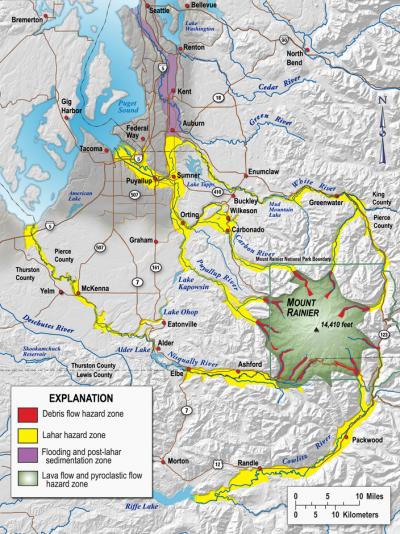 |
| Washington State Geographic Map |
Left & Right, Black & White, Wet & Dry...
 |
| Amount of Precipitation, Washington State |
There are several reasons as to why the western third of Washington
State is so wet. One of which is the
rain shadow effect. As the moist cool air
flows in from the Pacific Ocean, the Olympic peninsula and Puget Sound capture
all that moisture. This occurs not
simply because the weather rolls inland, but mostly in part to the two mountain
ranges that surround the Seattle-Tacoma area.
The Olympic mountains first to the west, and the Cascade Mountains to
the east. The abrupt increase in
elevation from sea-level to the tops of the Olympic Mountains causes the
already cool pacific air to quickly reach their due point. As the cold moist air is forced over the
mountains and cools, the water in the air is released on the Olympic Mountains
and in the Olympic National Park. This is
why this part of Washington is known for its high precipitation amounts. As the weather continues east towards the
Puget Sound and the Seattle area, the air quickly descends, it mixes with the
cool moist air being blow in through the Puget sound from the north by
Victoria, British Columbia. This helps
to keep the moisture in the air that travels through the Puget Sound. This is where the air again rises quickly up
the western slope of the Cascades, reaching its due point quickly, allowing the
rain to fall on the western slopes and Puget Sound areas of Washington. The Olympic Peninsula receives around a high of 200 inches of precipitation a year, where on the eastern side of the state in Spokane is typically less than 20 inches of precipitation a year.
 |
| Seattle to Spokane |
Now this is where the moisture stops, and the nomenclatures
about the Pacific Northwest with them. If
you were to drive on I-90 over the Cascades from Seattle east towards Spokane,
Washington, you would notice how the climate completely changes. The eastern two thirds of Washington State
are like most of California, Nevada, Utah, and Colorado; very dry and
arid. This is due to the Cascade rain shadow;
the Columbia River Basin stays flat and dry.
The biggest rains and weather differences come when the prevailing winds
blow from the south.
 |
| Air Mass Flow Diagram |
The moist air in the Pacific Northwest is a colder air. It comes for the Maritime Polar air that flows
in from the north Pacific. This keeps
the temperatures relatively cool and consistent, but is also the reason for all
the rain. Since it’s a maritime air
mass, this infers that it will be loaded with moisture unlike continental air
masses.
As the maritime polar air mass (cold front) flows towards the Pacific Northwest coast, it converges with the maritime tropical air mass (warm front), the cold front overtakes the warm front and forms an occluded front right over the pacific north west. This occluded front creates the possibility of a high amount of precipitation to be produced. This is the case in the Pacific Northwest and why Seattle and the surrounding areas are known for their excessive rain. as the front moves east, it reaches down into Oregon and northern California.
As the maritime polar air mass (cold front) flows towards the Pacific Northwest coast, it converges with the maritime tropical air mass (warm front), the cold front overtakes the warm front and forms an occluded front right over the pacific north west. This occluded front creates the possibility of a high amount of precipitation to be produced. This is the case in the Pacific Northwest and why Seattle and the surrounding areas are known for their excessive rain. as the front moves east, it reaches down into Oregon and northern California.
http://www.theweatherprediction.com/weatherpapers/118/
http://cses.washington.edu/cig/pnwc/pnwc.shtml
http://cses.washington.edu/cig/pnwc/pnwc.shtml









